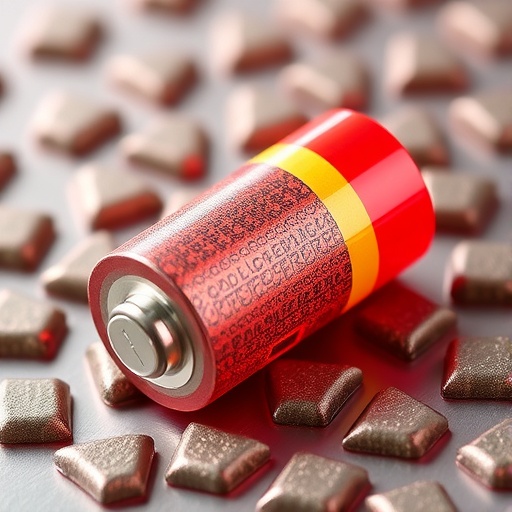The quest for suitable anode materials in sodium-ion batteries has become increasingly critical, primarily due to the inherent challenges posed by current technologies. Traditional lithium-ion batteries have dominated the energy storage market; however, their dependence on lithium raises concerns regarding resource scarcity and environmental sustainability. Sodium, being abundant and more widely available, presents a promising alternative. The introduction of the CoSbS-G composite signifies a substantial leap towards overcoming the limitations faced by sodium-ion batteries, thus generating significant interest among scientists and engineers alike.
The research team’s focus on the nanoscale structure of the CoSbS-G composite marks a crucial element in their methodology. By manipulating the material at the nanoscale, the team has increased the surface area and enhanced the electrochemical performance of the anode. This increased surface area facilitates more efficient ion transport during charge and discharge cycles, thereby improving the overall efficiency of the battery. Additionally, this nanoscale adjustment allows for the potential enhancement of capacity retention over time—a key metric in determining the longevity and reliability of battery systems.
.adsslot_2CFW4yrufg{ width:728px !important; height:90px !important; }
@media (max-width:1199px) { .adsslot_2CFW4yrufg{ width:468px !important; height:60px !important; } }
@media (max-width:767px) { .adsslot_2CFW4yrufg{ width:320px !important; height:50px !important; } }
ADVERTISEMENT
In their experiments, the researchers have reported that the CoSbS-G composite exhibits exceptional cycle stability and rate capability, making it highly competitive against traditional anode materials. The results reveal that the composite not only delivers high reversible capacity but also demonstrates superior performance when subjected to rapid charging and discharging conditions. This dual capability is crucial for modern applications where quick turnaround times are often required, such as in electric vehicles and high-performance electronics.
The interactions between the cobalt, antimony, and sulfur components within the CoSbS-G composite have been carefully studied, revealing synergistic effects that enhance its electrochemical properties. These interactions lead to improved ion storage mechanisms, ultimately translating to better energy storage performance. By leveraging the unique chemical properties of each element, the researchers have engineered a composite that not only meets but exceeds the basic requirements of a sodium-ion battery anode.
Furthermore, the commercialization potential of sodium-ion batteries, particularly with the advent of advanced materials like CoSbS-G, is worth noting. As manufacturers look for cost-effective and sustainable alternatives to lithium-based technologies, the findings from Zhang et al. may accelerate the shift toward sodium-ion systems. This could have far-reaching implications not only for the energy sector but also for policies surrounding resource usage and environmental impact.
A significant challenge that most battery technologies face is maintaining performance while keeping costs low. The CoSbS-G composite addresses this issue by utilizing abundant raw materials, thereby reducing overall production costs compared to current lithium-ion systems. This aspect is particularly appealing for large-scale battery implementations, where cost efficiency combined with high performance can make or break a project’s success.
As researchers continue to explore and refine the properties of the CoSbS-G composite, collaborative efforts across the scientific community are expected to emerge. The inherent benefits of collaborative research allow for a multiplicity of perspectives and techniques, which can only bolster the development of this promising anode material. Furthermore, partnerships between academia and industry may expedite the transition from laboratory breakthroughs to real-world applications.
Looking ahead, the study outlines a clear path for future research endeavors. While the performance of the CoSbS-G composite is promising, understanding the long-term effects of cycling on its structural integrity and electrochemical properties will be vital. Future investigations can explore the impact of different electrolyte compositions on the performance of the CoSbS-G anode, potentially unlocking further enhancements in battery design and efficiency.
In summary, as the world marches forward into a future where sustainable and efficient energy storage solutions are paramount, the findings by Zhang et al. stand as a beacon of hope. The development of the nanoscale CoSbS-G composite for sodium-ion battery anodes represents a significant step closer to achieving the ideal balance between performance and sustainability. This innovative research not only contributes to the scientific community but also resonates with global efforts to transition toward greener energy technologies.
The implications of this research echo throughout various sectors, promising advancements not just for consumer electronics but also for large-scale energy storage and electric vehicles. By harnessing the power of sodium-ion batteries, driven by groundbreaking materials like the CoSbS-G composite, we could redefine the boundaries of energy storage and usage in our increasingly electrified world.
The excitement surrounding this research underscores the essential role of continuous innovation in energy storage solutions. As technologies evolve, so do the methods and materials that drive them, highlighting the importance of supporting such research initiatives. The resilient pursuit of better alternatives to conventional energy sources could very well lead us to a new era of energy independence and sustainability, with sodium-ion batteries taking center stage.
In conclusion, the monumental advancements in sodium-ion battery technology brought forth by the CoSbS-G composite open up a myriad of possibilities. As the world aims for a cleaner and more sustainable future, the insights gained from this research will undoubtedly shape the trajectory of energy storage solutions. It shines a light on the potential for synergy between chemistry, engineering, and environmental science, ultimately leading us down a path of innovation and sustainability.
Subject of Research: Development of Nanoscale CoSbS-G Composite for Sodium-Ion Battery Anodes
Article Title: Nanoscale CoSbS-G composite for advanced sodium-ion battery anodes
Article References:
Zhang, L., Zhang, L., Huang, S. et al. Nanoscale CoSbS-G composite for advanced sodium-ion battery anodes. Ionics (2025). https://doi.org/10.1007/s11581-025-06622-5
Image Credits: AI Generated
DOI: https://doi.org/10.1007/s11581-025-06622-5
Keywords: Sodium-ion batteries, CoSbS-G composite, Nanoscale materials, Energy storage, Anode materials, Cycle stability, Electrochemical performance, Renewable energy technologies, Lithium alternatives, Sustainable energy solutions.
Tags: advanced battery technologiesanode materials for batteriesbattery lifespan improvementCoSbS-G compositeenhancing battery efficiencyenvironmental sustainability in batteriesnanoscale material developmentovercoming lithium-ion limitationsrenewable energy storage solutionsresource scarcity in energy storagesodium ion batteriessustainable energy alternatives





